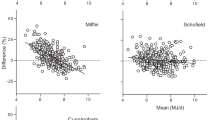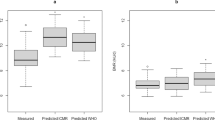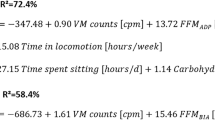Abstract
This study validated a simplified factorial method for measuring energy expenditure (EE) against EE measured by doubly labelled water (DEE), and investigated whether adjustment for excess post-exercise oxygen consumption (EPOC) and thermic effect of food (TEF) as described by Institute of Medicine (2002) improved the factorial measure. Seventeen normal weight subjects (10 females, seven males) were recruited from among university staff and students. Factorial EE was measured using a 16-activity-category method, published energy costs of activities and measured basal metabolic rate, before (FEE) and after (FEEadj) adjustment for EPOC and TEF, and by DEE. FEE underestimated daily EE by 14.6% relative to DEE (P=0.000), but this underestimate was improved to 5.1% (P=0.071) when FEE was adjusted for EPOC and TEF. Individual differences between DEE and FEEadj ranged from −20.2 to 17.6%, with 88% of subjects showing differences of less than ±12%.
This is a preview of subscription content, access via your institution
Access options
Subscribe to this journal
Receive 12 print issues and online access
$259.00 per year
only $21.58 per issue
Buy this article
- Purchase on Springer Link
- Instant access to full article PDF
Prices may be subject to local taxes which are calculated during checkout
Similar content being viewed by others
References
Alfonzo-Gonzalez G, Doucet E, Almeras N, Bouchard C, Tremblay A (2004). Estimation of daily energy needs with the FAO/WHO/UNU 1985 procedures in adults: comparison to whole-body indirect calorimetry measurements. Eur J Clin Nutr 58, 1125–1131.
Bahr R, Ingnes I, Vaage O, Sejersted OM, Newsholme EA (1987). Effect of duration of exercise on excess post-exercise oxygen consumption. J Appl Physiol 62, 485–490.
Bland JM, Altman DG (1986). Statistical methods for assessing agreement between two methods of clinical measurement. Lancet 1, 307–310.
Bratteby LE, Sandhagen B, Fan H, Samuelson G (1997). A 7-day activity diary for assessment of daily energy expenditure validated by the doubly labelled water method in adolescents. Eur J Clin Nutr 51, 585–591.
FAO/WHO/UNU (2004). Human Energy Requirements. FAO: Rome.
Haggarty P, McNeill G, Abumanneh MK, Davidson L, Milne E, Duncan G et al. (1994). The influence of exercise on the energy-requirements of adult males in the UK. Br J Nutr 72, 799–813.
IOM (2002). Physical activity. In: Institute of Medicine/Food and Nutrition Board (ed). Dietary Reference Intakes for Energy, Carbohydrate, Fiber, Fat, Fatty Acids, Cholesterol, Protein and Amino Acids (Macronutrients). National Academy Press: Washington, DC, pp 697–736.
Jones PJH, Martin LJ, Su WF, Boyd NF (1997). Canadian recommended nutrient intakes underestimate true energy requirements in middle-aged women. Can J Public Health 88, 314–319.
Leonard WR, Galloway V, Ivakine E (1997). Underestimation of daily energy expenditure with the factorial method: Implications for anthropological research. Am J Phys Anthropol 103, 443–454.
Morio B, Ritz P, Verdier E, Montaurier C, Beaufrere B, Vermorel M (1997). Critical evaluation of the factorial and heart-rate recording methods for the determination of energy expenditure of free-living elderly people. Br J Nutr 78, 709–722.
Seale JL, Klein G, Friedmann J, Jensen GL, Mitchell DC, Smiciklas-Wright H (2002). Energy expenditure measured by doubly labeled water, activity recall, and diet records in the rural elderly. Nutrition 18, 568–573.
Speakman JR, Nair KS, Goran MI (1993). Revised equations for calculating CO2 production from doubly labeled water in humans. Am J Physiol 264, E912–E917.
Walsh MC, Hunter GR, Sirikul B, Gower BA (2004). Comparison of self-reported with objectively assessed energy expenditure in black and white women before and after weight loss. Am J Clin Nutr 79, 1013–1019.
Warwick PM (1989). Predicting food energy requirements from estimates of energy expenditure. Aust J Nutr Diet 46 (Suppl), S1–S28.
Warwick PM, Baines J (1996). Energy expenditure in free-living smokers and nonsmokers: comparison between factorial, intake-balance, and doubly labeled water measures. Am J Clin Nutr 63, 15–21.
Warwick PM, Busby R (1993). Prediction of twenty-four-hour energy expenditure in a respiration chamber in smokers and non-smokers. Eur J Clin Nutr 47, 600–603.
Warwick PM, Edmundson HM, Thomson ES (1988). Prediction of energy expenditure: simplified FAO/WHO/UNU factorial method vs continuous respirometry and habitual energy intake. Am J Clin Nutr 48, 1188–1196.
Withers RT, Smith DA, Tucker RC, Brinkman M, Clark DG (1998). Energy metabolism in sedentary and active 49- to 70-yr-old women. J Appl Physiol 84, 1333–1340.
Author information
Authors and Affiliations
Corresponding author
Additional information
Guarantor: PM Warwick.
Contributor: PM Warwick.
Rights and permissions
About this article
Cite this article
Warwick, P. Factorial estimation of daily energy expenditure using a simplified method was improved by adjustment for excess post-exercise oxygen consumption and thermic effect of food. Eur J Clin Nutr 60, 1337–1340 (2006). https://doi.org/10.1038/sj.ejcn.1602460
Received:
Revised:
Accepted:
Published:
Issue Date:
DOI: https://doi.org/10.1038/sj.ejcn.1602460



